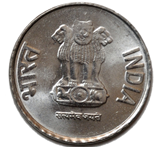India | |
| Value | ₹2 |
|---|---|
| Mass | 4.07 g |
| Diameter | 23 mm |
| Edge | 50 wide serrations |
| Composition | Ferritic stainless steel |
| Years of minting | 1982 – present |
| Circulation | Wide |
| Obverse | |
 | |
| Design | Lettering of "भारत" on left, "INDIA" on right, Lion capital at centre with the lettering "सत्यमेव जयते" below it. |
| Designer | RBI |
| Design date | 2011 |
| Reverse | |
 | |
| Designer | RBI |
| Design date | 2011 |
The Indian 2-rupee coin is a denomination of the Indian rupee. The 2 rupee coin was introduced in India in 1982. Until then, the Rs.2 was in circulation in banknotes. The old Rs.2 coin was minted with cupro-nickel metal. The new Rs.2 coin was minted in ferritic stainless steel.